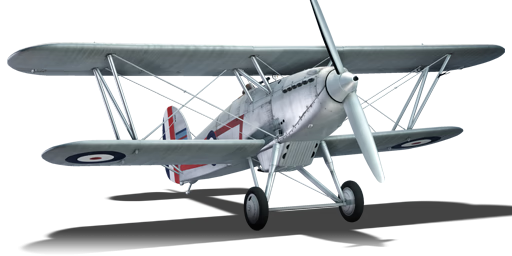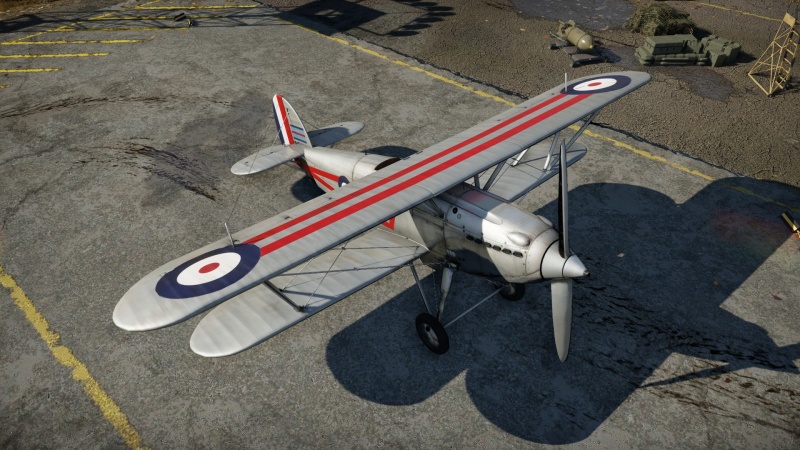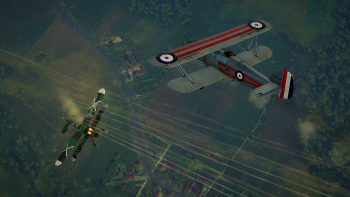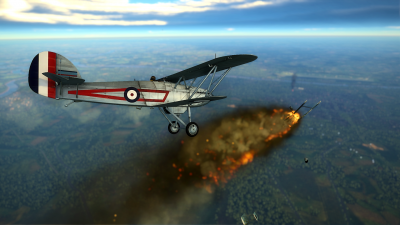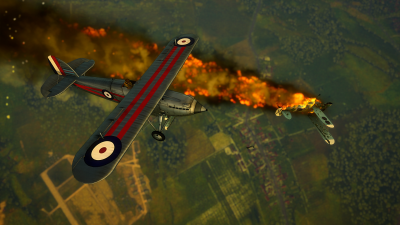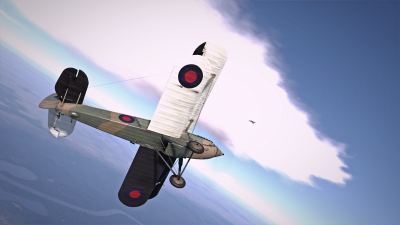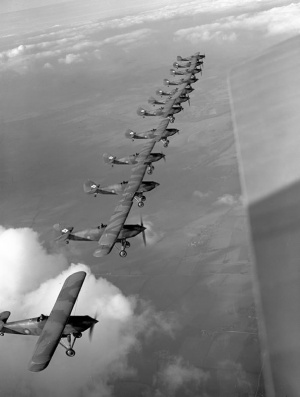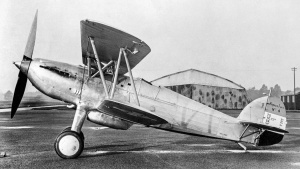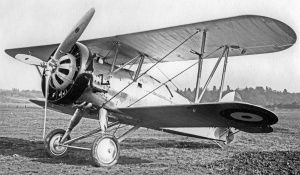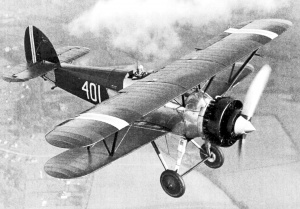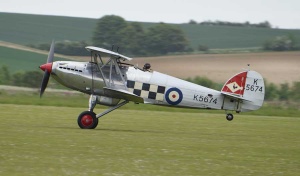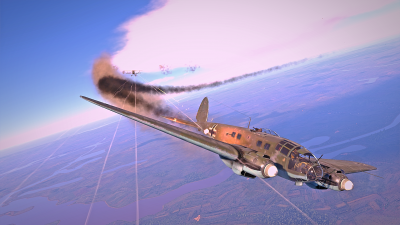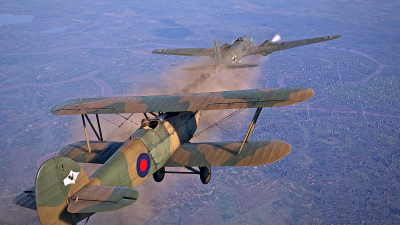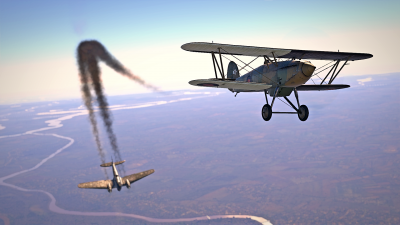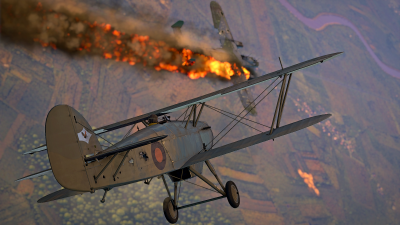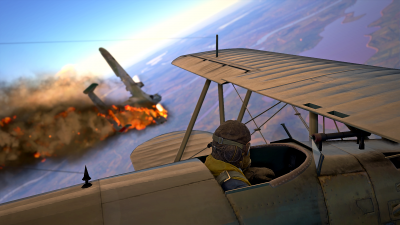Fury Mk I
| This page is about the British fighter Fury Mk I. For the other version, see Fury Mk II. For other uses, see Fury (Disambiguation). |
Contents
Description
The Fury Mk I is a reserve rank I British fighter with a battle rating of 1.0 (AB/RB/SB). All-metal single-seat biplane with an open cockpit and fixed landing gear. It has been in the game since the start of the Open Beta Test prior to Update 1.27.
The Fury Mk I is one of the three reserve fighters in the British tree - the other two being the Nimrod Mk I (a naval version Fury), as well as the Fury Mk II. As a reserve plane, the Fury isn't a manoeuvrable or fast plane. Its armament, two 7.7 mm machine guns Which is one of the worst weapons among reserve aircaft.
The Furies in all their variants also turn decently, though they do tend to bleed energy easily and aren't the best planes in climbing or acceleration. The modelled fixed pitch prop will mean not much power is around for climbing at the start of the match - a problem also currently shared with the later Gladiators.The first prototype was presented in 1927. For the first time, a biplane completely ready for production took off in March 1931 and entered service with the RAF in May of the same year. Also was in service with Yugoslavia, Iran, South Africa (Union of South Africa). He participated in the Spanish Civil War, as well as in the Second World War, but in most cases was used for public performances. Fury Mk I did not become a mass RAF (Royal Air Force) fighter, however, Fury pilots were considered an elite. A total of 117 Fury Mk I modification fighters were produced in five series. In 1937 the Fury Mk II was introduced with a more powerful engine. It replaced the Fury Mk I in production and on airfields.General info
Flight performance
| Characteristics | Max Speed (km/h at 4,100 m) |
Max altitude (metres) |
Turn time (seconds) |
Rate of climb (metres/second) |
Take-off run (metres) | |||
|---|---|---|---|---|---|---|---|---|
| AB | RB | AB | RB | AB | RB | |||
| Stock | 385 | 371 | 8100 | 16.2 | 16.9 | 13.7 | 13.7 | 232 |
| Upgraded | 403 | 394 | 15.8 | 16.0 | 19.2 | 15.7 | ||
Details
| Features | ||||
|---|---|---|---|---|
| Combat flaps | Take-off flaps | Landing flaps | Air brakes | Arrestor gear |
| X | X | X | X | X |
| Limits | ||||||
|---|---|---|---|---|---|---|
| Wings (km/h) | Gear (km/h) | Flaps (km/h) | Max Static G | |||
| Combat | Take-off | Landing | + | - | ||
| 600 | 600 | N/A | N/A | N/A | ~11 | ~5 |
| Optimal velocities (km/h) | |||
|---|---|---|---|
| Ailerons | Rudder | Elevators | Radiator |
| < 260 | < 200 | < 300 | > 200 |
| Compressor (RB/SB) | ||
|---|---|---|
| Setting 1 | ||
| Optimal altitude | 100% Engine power | WEP Engine power |
| 3,705 m | 600 hp | N/A |
Survivability and armour
The Fury Mk I was an aircraft that was stripped of all which was unnecessary to enable it to be the lightest and fastest possible. Like many biplanes just before the start of World War II, the only protection afforded the pilot was the wood and canvas around him and the engine at the front of the aircraft. The best course of protection for this aircraft is to gain the element of surprise as it will not take much to damage critical components or knock out the pilot. All critical modules are concentrated in the forward fuselage area so attacks from the front or the side tend to do the most damage quickly.
- No armour protection
- Largely wood and canvas construction
- Self-sealing fuel tanks
Modifications and economy
Armaments
Offensive armament
Use Universal or Stealth rounds with the Vickers K guns but keep in mind that unlike the current modelled Brownings as used on Gladiators, Hurricanes and Spitfires, these 7.7 mm guns won't do much damage unless you aim for the most vulnerable parts of your opponent's aircraft.
Usage in battles
If you want to use the Fury, the best advice is to climb a bit at the start of the match so you at least have some energy to work with. The best speed forgaining altitude is 220 km/h. Plan manoeuvres ahead and go for easy targets such as inattentive planes and attackers destroying ground vehicles.
The Fury Mk I is a typical reserve aircraft in that it is an unremarkable plane. It is neither outstanding in speed, or even weapons loadout. Though contemporary aircraft may have a speed advantage, beefier weapons or even more manoeuvrability, the Fury Mk I can still find its place on the battlefield in both in air battles and the ground attack game.
- Ground Attack
The Fury Mk I has a crazy low stall-speed which allows it to circle anti-aircraft artillery or anti-aircraft vehicles easily. Though the plane's Vickers 7.7 mm machine guns are relatively weak, they can wreak havoc on the ground targets if enough bullets connect with their targets. If there are no enemy aircraft circling above the Mk I, then it can leisurely eliminate the ground targets, even tightly grouped vehicles. Even without access to bombs, the Fury Mk I can be an effective ground attacker.
- Air-to-air Attack
With many contemporary aircraft using faster firing machine guns, larger calibre guns or just more of them, it will take a skilful Fury pilot to balance or tip the scales. With 600 rounds of ammunition for each Vickers machine gun, there is a lot to work with; however, it is to the pilot's detriment to spray bullets everywhere. To make the most impact with the 7.7 mm rounds, the best chances to hit the enemy are when while in close. The longer the shot, the more likely bullets will either miss or harmlessly bounce off the target. Attacking close in between 100 and 300 m gives the best chances in critically damaging the enemy. Unless the pilot pulls off a pilot snipe and knocks out the pilot, chances are it may take a couple passes to inflict enough damage to send the target to the ground in flames. Close in attacks may offer the best opportunities to damage the enemy, but it can make for some hectic flying.
The 7.7 mm bullets fired at aircraft fuselage do relatively little damage; therefore, it is crucial to target critical components such as the pilot, engines, oil coolers, and fuel tanks to eliminate the enemy effectively. Aircraft wings can also be susceptible to shenapping if enough bullets perforate the skin and structure.
One use for the Fury Mk I is as an early interceptor aircraft against bombers. While Do-17, TBD-1, SB 2M, Ki-21, and F.222.2 bombers have various defensive gunners, they are not impossible to shoot down with the Fury. The pilot does need to watch how they approach the bombers. Typically flying in from the front or the underside of the bombers allows for an unscathed approach. However, if you find that you must approach with a defensive position firing at you, make small adjustments to stay out of the line of fire and wait for the gunner to run out of ammunition before levelling off and taking a shot. Chances are you can knock out the gunner or even work on taking out the engines. A crippled bomber easily allows the more manoeuvrable biplane to make enough passes to finish the job.
Manual Engine Control
| MEC elements | ||||||
|---|---|---|---|---|---|---|
| Mixer | Pitch | Radiator | Supercharger | Turbocharger | ||
| Oil | Water | Type | ||||
| Controllable | Not controllable Not auto controlled |
Not controllable Not auto controlled |
Controllable Not auto controlled |
Combined | Not controllable 1 gear |
Not controllable |
Pros and cons
Fury Mk I is hard to implement in combat. It has few advantages over biplanes, and it is difficult to fight monoplanes on it, since the Fury has poor weapons and in a long turning battle it loses all speed and becomes easy prey.
Pros:
- Turns well for a biplane
- Good vertical maneuverability
- Incredibly low stall speed
- Engine never overheats, only on the really hot maps
Cons:
- Only has two rifle-calibre 7.7 mm machine guns, a challenge to damage enemy aircraft
- Loses energy quite easily, mostly able to turn just once or twice
- Not very beginner-friendly due to its flying characteristics
- There is not WEP Engine power
History
In-game description
The Hawker Fury was a single engine, single-seat biplane of composite structure which first entered service in May 1931. The Fury was designed by H.G. Hawker Engineering Co. Ltd (Hawker Aircraft Ltd since 1933) under the direction of Sidney Camm. The Fury prototype made its first flight in March 1931 and after a successful test and evaluation period, entered production for service in Britain's Royal Air Force. However, the Fury was an expensive aircraft and, with Britain being in the grip of a financial depression, initially only enough aircraft were ordered to equip three squadrons; Nos 1, 25 and 43 Squadrons.
An elegant aircraft with streamlined fuselage contours, the Fury Mk I was the first RAF fighter with a speed exceeding 322 km/h (200 mph).
Most aircraft were equipped with a 525 hp liquid-cooled in-line twelve-cylinder Rolls-Royce Kestrel IIS engine and a wooden twin-bladed Watts propeller, although several alternative powerplants became available during the Fury's service life.
The Fury's fuselage, wings, and tail had a metal framework and a fabric skin. The skin of the forward fuselage up to the cockpit and the engine cowling was made of duralumin sheets. Ailerons were fitted to the upper wing; nevertheless, due to their large area, they were very responsive and provided the aircraft with a high roll rate.
The armament consisted of two synchronous Vickers Mk.IV, mounted in front of the cockpit. Whilst the Fury was an excellent fighter when it first entered service, it did mark the end of an era as one of the last open cockpit, biplane fighters produced by Britain. Its fixed undercarriage, fabric skin and twin Vickers guns were reminiscent of fighters of the First World War, and when it was replaced in front line service with the RAF in 1939, it truly was a relic of a bygone era.
A total of 117 Fury Mk I fighters were produced, in five series.
The Furies were armed with:
United Kingdom:Fury Mk I and Mk II Squadrons in service:
No. 1 Squadron RAF - February 1932 - November 1938
No. 25 Squadron RAF - February 1932 - October 1937
No. 41 Squadron RAF - October 1937 - January 1939
No. 43 Squadron RAF - May 1931 - January 1939
No. 73 Squadron RAF - March 1937 - July 1937
No. 87 Squadron RAF - March 1937 - June 1937
Yugoslavia: Fury has been upgraded for Yugoslavia. Yugoslav Fury was equipped with a 745 hp Kestrel XVI engine and are often found with machine gun mounts under the wing. Yugoslavia has purchased 10 Furies which arrived in the UK. Licensed production of 40 of these Fury was organized in Yugoslavia at the factories Ikarus (24 units) and Zmaj (16 units). At the beginning of the April 1941 invasion of Yugoslavia, 25 Furies operated: 35th Fighter Group: 109th Fighter Squadron - 6 Furies, 110th Fighter Squadron - 5 Furies 36th Fighter Group: 111th Fighter Squadron - 7 Furies, 112th Fighter Squadron - 7 Furies.
Iran: For Iran (then Persia) a modification was made with a Pratt & Whitney Hornet S2B1g radial piston engine and a three-bladed propeller. Iran ordered 16 of these Furys in January 1933. Six more aircraft with a 550 hp Bristol Mercury VISP radial piston engine (410 kW) and a two-blade propeller were ordered in May 1934. Several Hornet-powered Furys were upgraded.
Spain: Improved version of the Fury Mk I, three hulls powered by a 700 hp Hispano-Suiza 12Xbrs engine. were built for Spain. They were sent unassisted to Spain on July 11, 1936, unarmed until the start of the civil war. The cars that arrived were supposed to be models for their proposed construction at the Hispano-Suiza plant in Guadalajara, with the aim of using the Nieuport-Delage NiD 52, but due to the war, work was completed. They were transferred to the Republican Spanish Air Force. One of these Furies, Pilot Sergeant Felix Urtubi, was killed in an emergency landing on Francoist territory, was captured and repaired, but was not included in the group. Sergeant Urtubi managed to escape. Another Republican aircraft was used during the defense of Madrid until it was shot down in November 1936. The first aircraft entered the armed forces of the Republic until 1938, when it was written down due to the availability of spare parts.
SA (Union of South Africa): acquired 7 machines in 1937. With the outbreak of World War II, 24 Furys were transferred to them from the RAF reserve.
Portugal: A modified version of the Fury Mk I, three aircraft powered by a Rolls-Royce Kestrel II piston engine were linked for Portugal.
Norway: One test engine, powered by a 530 hp Armstrong-Siddeley Panther IIIA radial piston engine. was built for Norway, but the order for Fury Norway did not fit them.
Restoration of the last Fury.
Historically, no known example of the Hawker Fury has survived. When removed from service, they were either dismantled or destroyed. This beautiful aircraft seemed lost to the world forever until it was accidentally discovered in South Africa. On a tip from the Royal Air Force Museum, a team from the Historic Aircraft Collection headed to a farm in South Africa, where they discovered the extremely rare remains of a Hawker Fury Mk.1 fighter.
This fighter was adopted into service with the RAF in 1935 and received the serial number K5674. He was transferred to storage, and then transferred to his first combat squadron, No. 43 Squadron "Fighting Cocks". It was the personal aircraft of flight officer Frédéric Rozier from December 1936 to January 1939. The aircraft bore the name "Queen of the North and South", although it is not known if this was simply the name Rosier gave his aircraft or if it was not actually painted on the fuselage. The last time Officer Rosier flew this Fury was on February 22, 1939 - the entry in his logbook for that day read: “Last flight in the Queen of the North and South. Excellent!" After service periods with RAF units at Kemble and Sealand, this Fury was withdrawn from service in August 1940.
The future of the aircraft was now tied to a new career in South Africa. The aircraft was unloaded at Durban at the end of 1940 and reassembled for the 13 Squadron of the South African Air Force. Unfortunately, his career in South Africa proved to be short. On March 31, 1941, piloted by Lieutenant Peter M Hedley, the aircraft ran out of fuel and made an emergency landing. Fortunately, the pilot was not injured, but the aircraft received significant damage and was taken to the airbase, where it was decommissioned. From this date, little is known of the aircraft until its remains were discovered on farmland and identified as the Fury Mk.1 in 1992, after which it became the subject of one of the most ambitious restoration projects.
Will this extremely rare aircraft ever take to the air again? From the very beginning, the team was only interested in taking on this project if they could restore the aircraft to its original, authentic condition, and it cannot be overstated how challenging this task would actually be. Since the restorers had few original parts, and the complex manufacturing processes used in its construction have long since disappeared. Retrotec Ltd is a specialist historic aircraft restoration company that has built a reputation for engineering excellence in restoring rare types of aircraft. Already associated with a number of major aviation projects, the company is particularly experienced with classic Hawker biplanes, but despite these unique credentials, the Fury was to be the most challenging project they attempted.
After a gigantic eighteen year old restoration was completed, the K5674 was first introduced to the historic aviation world at IWM Duxford in June 2011. Later that year, the aircraft was exhibited at the Goodwood Revival meeting, where it was awarded first place in the Spirit of Aviation section, a fitting tribute to this fighter. The aviation world began to worry. On July 30, 2012, experienced pilot Lieutenant Charlie Brown in a Hawker Fury Mk.I K5674 took off from the runway, triumphantly completing this impressive and unique restoration project.
Media
- Skins
- Images
See also
- Fury Mk.2 - Upgrade of Fury Mk.1.
- Nimrod Mk.1 - is a deck cousin of the Fury.
External links
| Hawker Aircraft Limited | |
|---|---|
| Biplane fighters | |
| Fury | Fury Mk I · Fury Mk II |
| Nimrod | Nimrod Mk I · Nimrod Mk II |
| Scout plane | Osprey Mk IV |
| Piston fighters | |
| Hurricane | Hurricane Mk I/L · Hurricane Mk.I/L FAA M · Sea Hurricane Mk IB · Sea Hurricane Mk IC · Hurricane Mk IIB/Trop · Hurricane Mk IV |
| Typhoon | Typhoon Mk Ia · Typhoon Mk Ib · Typhoon Mk Ib/L |
| Tempest | Tempest Mk V · Tempest Mk V (Vickers P) · Tempest Mk II |
| Fury | Sea Fury FB 11 |
| Jet fighters | |
| Hunter | Hunter F.1 · Hunter F.6 · Hunter FGA.9 · ◌Hunter F.58 |
| Sea Hawk | Sea Hawk FGA.6 |
| Harrier | Harrier GR.1 · Harrier GR.3 |
| Export | ▄Hurricane Mk I/L · ▂Hurricane Mk IIB · J34 · ◄Sea Hawk Mk.100 · AV-8A · AV-8C |
| Captured | ▀Tempest Mk V |


